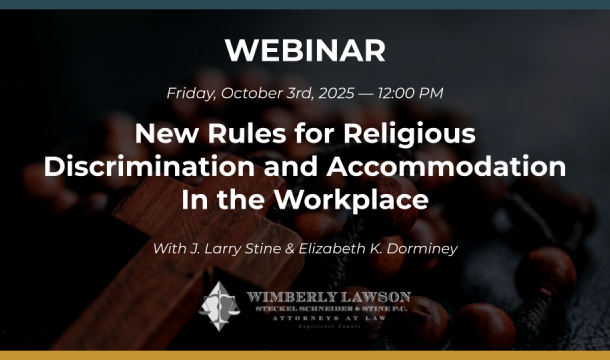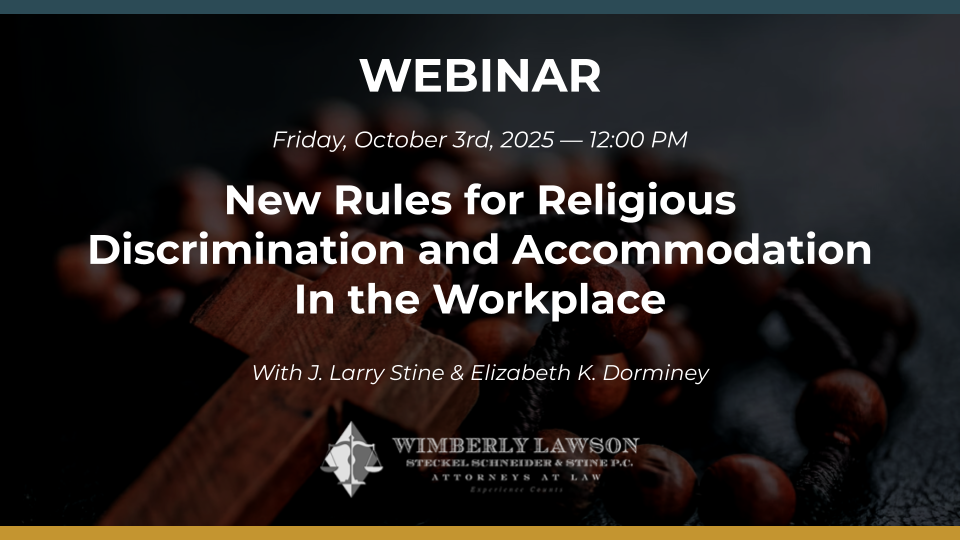Breaking Up is Hard to Do: Handling Employee Terminations with Dignity
Perhaps the most serious decisions which employers ever have to make regarding employees are those decisions concerning termination of employment. Those decisions often must be made in order to reduce labor costs and save the business in the long term. At the same time, the consequences to the affected employees can be seemingly disastrous, especially in a job market with few prospects. While terminating an employee is almost always difficult, there are ways of handling the process that can allow an employee to leave his/her job with dignity and at the same time, minimize the employer's risk of litigation and bad public relations.
Most decisions involving the discharge of employees are made by employers for legitimate reasons and without any bad motive. Nevertheless, more and more often, discharge actions are being challenged by disgruntled employees before administrative agencies and courts of law, based on claims that the employer illegally discriminated or retaliated against the employee because of some protected status or that the employer breached some other legal duty it owed to the employee. A seemingly unimportant oversight, inadequate attention to details, or carelessness in carrying out a discharge can result in tremendous monetary liabilities, bad publicity and poor employee relations.
As the singer says, "breaking up is hard to do." This is particularly true when an employer decides that an employee must be discharged. Whether the reason is misconduct, poor performance, or reduction in force, the prudent employer should ask itself a lot of questions before calling the employee in to hear the bad news. If there is any question as to whether the termination may violate state or federal law, a consultation with competent employment counsel before the termination is effectuated is prudent.
Although the law does not normally require an employer in a non-union setting to give the employee any reason for discharge unless there is a specific employment agreement or state statute that requires otherwise, failing to provide this information is not considered a good practice. Most employees want to know the reason or reasons that they no longer have a job. Thus, an employer should give a discharged employee a complete and truthful explanation for his or her discharge. Complete explanations preserve all the reasons for a full defense in the event the employee brings a lawsuit. Sometimes the clear and complete explanation itself convinces the employee of the futility of a lawsuit. Truth always provides a complete defense to defamation, and normally there can be no defamation without a publication to third parties. Giving the complete and true explanation every time helps establish and maintain the company's credibility with employees and, in the event of a lawsuit, with the court. Credibility provides the best defense to allegations that the employer used the reasons as a pretext to cover up illegal discrimination.
Whatever the reason for the discharge, the manner in which the news is delivered can influence the manner in which it is received. If the employee is treated with respect, he or she is more likely to accept the news gracefully. The employer also should be prudent to avoid opportunities for sabotage or revenge.
1. Clear the decision through management and human resources. Examine the employee's personnel file prior to the termination meeting to learn whether the employee is at risk for a violent reaction.
2. Establish and follow standard procedures. This should include having the employee surrender keys, security passes, etc. Having a checklist will make it appear less personal to the employee and more like a normal administrative procedure.
3. Schedule the meeting for the end of the business day. Summon the employee to a private office or conference room for the meeting. You may choose one near an exit for a discreet departure.
4. Communicate the decision in clear, non-threatening and non-accusing language.
5. Put all administrative arrangements in writing
6. Have a witness present if necessary.
While some popular television personalities may simply say "You're Fired" to a departing employee and show them the door, that is not really the best way to communicate a termination decision. The employer that handles employee terminations with no thought as to the dignity of the terminated employees may find itself embroiled in litigation brought by bitter former employees and marked with a poor reputation that makes attracting and hiring quality employees very difficult.

Kathleen J. Jennings is a former principal in the Atlanta office of Wimberly, Lawson, Steckel, Schneider, & Stine, P.C. She defends employers in employment matters, such as sexual harassment, discrimination, Wage and Hour, OSHA, restrictive covenants, and other employment litigation and provides training and counseling to employers in employment matters.
Related Content
Get Email Updates
Recent Content

Trump Nominates Appointments to NLRB and EEOC but Policy Changes Likely to Be Delayed

DOL Launches Self-Audit Programs Designed to Help Employers Improve Compliance

DOL Must Release EEO-1 Reports to the Public under Open Records Laws

Current Advice on Active-Shooter Situations

New Policy for Federal Workers and Religious Expressions

